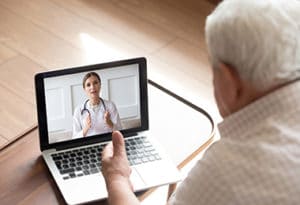
With over 54 million Americans over the age of 65 and 85% of them living with at least one chronic health condition, the need for telehealth services has never been greater. Telemedicine enables people who have traditionally struggled to access adequate medical care to talk to a provider over a secure internet connection with just a few clicks of the mouse or taps on their smartphone.
The aging population in the United States can benefit significantly from easy access to healthcare through telemedicine services.
How does telemedicine expand the availability of care?
Historically, when a person needed medical attention, they would travel to their nearest physician’s office, clinic, or hospital. While there are many benefits to seeing your healthcare provider in person, this isn’t always a feasible feat.
The COVID-19 pandemic made everyone more aware of the health risks of going to any public place, let alone a medical practice. As a result, since March 2020, telemedicine services have become widely available, allowing anyone to access healthcare services remotely.
However, even before COVID-19 began its rampage across the United States, many people struggled to access the healthcare services they needed. Many Americans live in remote rural communities where the closest urgent care or hospital is over a hundred miles away. Many Americans are shut-in, unable to leave their homes without assistance, even if they live near an appropriate healthcare provider. Additionally, many Americans have chronic or acute illnesses that require specialist care that isn’t available in their local area.
Who benefits from telemedicine services?
At a macro level, everyone, from patients to providers, benefits from the availability of telemedicine.
Patients
Patients can access healthcare from anywhere. Eliminating the need for travel means that people who have mobility issues or a lack of reliable transportation don’t need to stress about organizing rides or assistance. Those who have child or eldercare responsibilities don’t have to spend time or money on sitters. People who have commitments that make it challenging to make it to doctor’s appointments during traditional business hours can meet with their provider from their office or another private room, eliminating the need to take time off work or miss out on pay.
Providers
It’s not just patients who benefit from telemedicine services. Healthcare providers also see fewer patient no-shows, which means they see more patients and have more billable time, increasing their revenue. When you eliminate the common causes of missed appointments and provide alternative methods for patients to meet with you, your bottom-line flourishes.
How does telemedicine apply to senior care?
While many aging people maintain their independence and are able to drive or get around without assistance, many people over the age of 65 are shut-in or require additional care when leaving their homes. Telemedicine offers an alternative channel to access healthcare for patients who may otherwise face obstacles when making or traveling to an appointment.
Over 4.5 million American senior citizens use home healthcare services every year, and millions live in assisted living or nursing care communities. Additionally, over 40% people over 65 have more than one chronic health condition that requires routine medical care. How much easier would these people’s lives be if they could get the medical care they needed from the comfort and safety of their own homes.
Making healthcare more accessible increases patient compliance with appointments, prescription use, and lifestyle modifications. Enhanced compliance leads to better health outcomes, higher quality of life, and improved satisfaction levels.
How can I introduce telemedicine to a technologically illiterate population?
The memes and jokes about aging family members relying on younger generations for tech support paint a dismal and inaccurate picture of seniors’ ability to use technology. While using some technology may not be intuitive for those who grew up prior to the advent of the internet, telemedicine services, such as Curogram, are designed to create a simple user experience. Whatever platform you choose, you can teach your patients to use the program with a few simple steps.
Help them download the app
When you see a patient in your office, ask them about their interest in telemedicine services and their access to the internet at home. You can help them download the app or provide a handout with step-by-step instructions on how to access the platform from a computer at home.
Provide in-office or video training
You and your staff can also provide training on how to use a telemedicine platform. You can walk them through the steps of logging in and using the platform to talk to their provider. As with downloading, your patients may appreciate a handout with detailed instructions to follow at home.
Get the family involved
If necessary, you can train your patients’ families on how to access and use your telemedicine platform. Of course, you will need to obtain your patients’ permission before talking to anyone, even their family, about their healthcare to avoid costly HIPAA violations.
Curogram can help.
Curogram is a best-in-class patient engagement and telemedicine platform. Our easy-to-use software helps healthcare providers offer personalized care to patients who can’t always make it into the office — regardless of the obstacle. Our simple user interface allows even the least tech-savvy patients to make appointments, complete registration forms, and meet with their providers with no difficulty. If you or your patients would benefit from easy-to-use telemedicine services, contact Curogram today to learn more about our platform and how we can help your organization thrive.